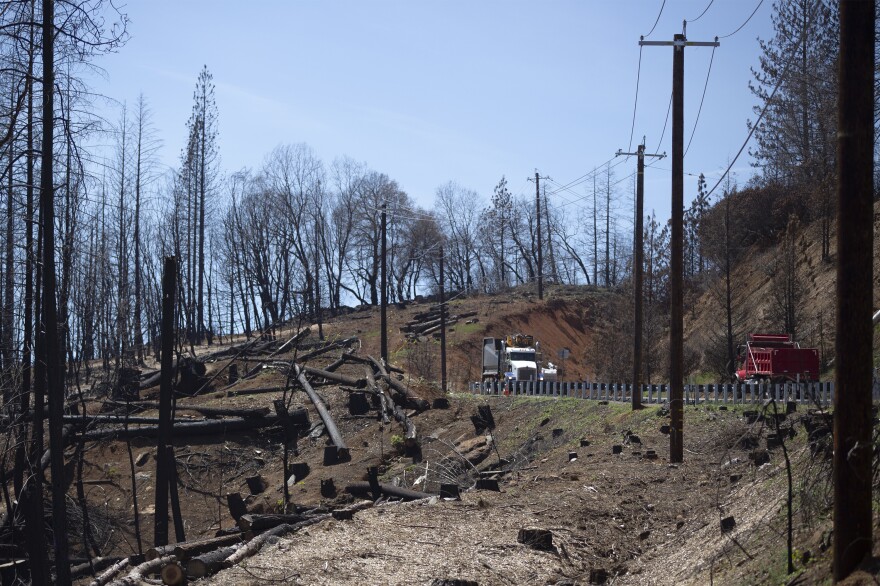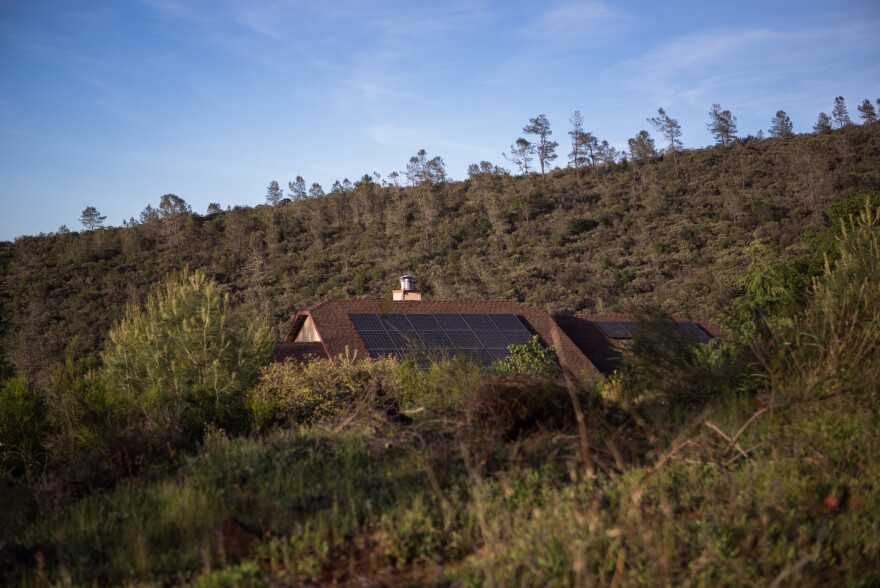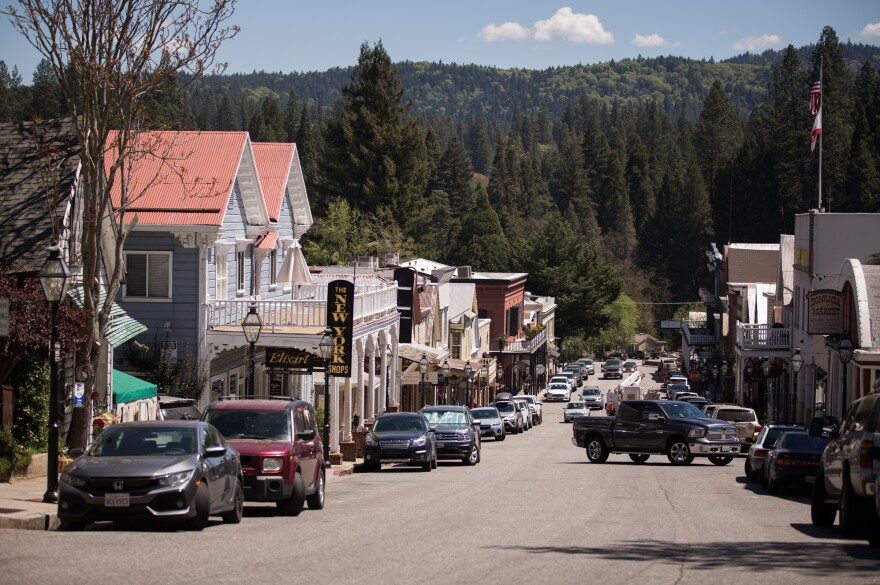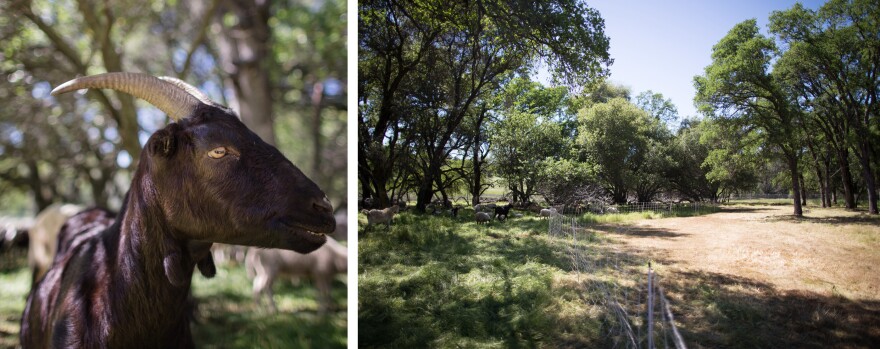Dan Efseaff, the parks and recreation director for the devastated town of Paradise, Calif., looks out over Little Feather River Canyon in Butte County. The Camp Fire raced up this canyon like a blowtorch in a paper funnel on its way to Paradise, incinerating most everything in its path, including scores of homes.
Efseaff is floating an idea that some may think radical: paying people not to rebuild in this slice of canyon: "The whole community needs some defensible space," he says.
Residents would get expanded green space for recreation and a vital safety buffer to help protect Paradise from future fire calamities. "We would work with either landowners on easements," he suggests, "or looking at them from a standpoint of some purchases in here."
"There are areas you just don't build in," he says.
Right now it's merely a vision.

The disaster industrial complex
He is up against the two-centuries-old American ethos to build, build, build, no matter the costs or the wisdom. It's an ethos baked into the federal disaster response system, what critics call the "disaster industrial complex" — a system constructed around responding to natural disasters, delivering immediate and long-term aid.
Politicians vow to rebuild.
The federal agencies swoop in.
The signs sprout: "Paradise Strong!" and "We Will Rebuild!"
But wildfire and recovery experts warn that this immediate impulse to re-create what was there before the disaster is misguided, expensive and dangerous.
There need to be more areas where building is limited, they argue, especially with the extraordinary buildup of forest fuels after a century of suppressing wildfire and a warming climate.

The career fire, over and over again
Many veteran wildland firefighters are saying the same thing.
"Every year, starting at about 2014, we thought we were seeing the career fire. We thought, 'We can't get much worse.' And every year it was getting worse," says Ken Pimlott, who fought wildfires and led men and women doing the same for more than three decades. Pimlott recently retired as the director of the state agency known as Cal Fire. "Firefighters are seeing and living climate change firsthand," he says.
His last five or six seasons, Pimlott says, you could feel the difference in the winds: more intense gusts fueling blowtorch-fast blazes that were bigger and lasted longer.

"You know, we're recording 70- and 80-mile-an-hour gusts in many of the locations where these fires are occurring," he says. In the 2017 Thomas Fire in Southern California, a red flag alert — the highest fire and wind warning — lasted for an unprecedented 13 days.
"These aren't random. These are truly weather pattern changes that are being fueled by a changing climate," he warns.
In the past two years California has seen its deadliest and most destructive wildfires on record, including the Camp Fire in Butte County, which killed 85 people in and around Paradise and torched more than 19,000 structures.
Wildland urban interface
I met up with Pimlott in the Pine Hill Preserve in Cameron Park, a suburban community in the Sierra Nevada foothills 30-plus miles east of Sacramento.
I worry about it every day. There are hundreds of communities like those just here in California. It's just a matter of time.
Cameron Park is a small example of a big problem across the West: Wooden backyard fences for comfortable homes mark a fragile, artificial line between wildland and suburbia. It's the classic wildland urban interface. The growth of these areas where homes and forests mix is a fire challenge across the country.
This community is galvanizing itself like it's galvanizing itself for a war.
"We really need to change the conversation to ahead of the fire occurring," Pimlott says.
Across the West, as development expands into this interface, Pimlott says, it is a kind of ticking firebomb. The potential site of future Paradises. "I worry about it every day. There are hundreds of communities like those just here in California. It's just a matter of time."
Don't see the graphic above? Click here
Almost half of new homes built in the U.S. are in this interface where development meets highly combustible vegetation.

In California, the challenge is acute: About quarter of the state's population — 11 million people — lives in high- or very high-fire-risk areas. One in three homes in the state is in this fire-prone area — from parts of Malibu to the Oakland hills to Paradise. Research shows that 75 percent of buildings destroyed by wildfire in California are in these WUI zones.
I don't know what more proof you need of the sense of urgency.
A 1991 wildfire in the steep, densely populated Oakland and Berkeley hills killed 25 people and destroyed nearly 3,500 homes and apartments. That firestorm prompted the state to better map fire hazard zones and create tough new building codes for fire safety.
During an April 2019 visit to those same East Bay hills that burned, Gov. Gavin Newsom made the case for better fire preparedness. "Over the last two years we've lost 139 lives; 2.8 million acres have been lost to wildfires," Newsom said. "Ten of the most destructive fires have happened since just 2015. ... I don't know what more proof you need of the sense of urgency."

Defensible space is not enough
Encouraging people to have an evacuation plan and create a 100-foot buffer of "defensible space" around their home — what firefighters have traditionally called basic wildfire preparation — are definitely important, Pimlott says.
But it's not enough. He would like to see the Paradise tragedy spur broader discussions about where people can safely live.
"Certainly I'm not advocating a ban on building in the urban interface. I think that obviously people are going to move and [there's] landowner rights, all of that," he says. "But at the end of the day we need to be looking at every development at every home and seeing if we can mitigate all aspects of [wildfire] before we build. And if we can't, then maybe we have to make a decision that that's not the right place."
California lawmakers are not seriously debating new limits on where people build. Plans for new, large developments in fire-prone areas continue, many prompting lawsuits. And some warn it's not practical to relocate or buy out hundreds of thousands of people. But Paradise has changed the conversation.
After the Camp Fire leveled the town, Newsom declared a state of emergency — suspending some environmental regulations to fast-track tree removal, fuel reduction and firebreaks in 35 fire-vulnerable areas around the state.
Newsom has also beefed up spending on firefighting, including new equipment and training, and has added funds to assess the effects of power line de-energizing by utilities in response to wildfires, and more.

The next Paradise
But many fire-exposed communities remain scared. They want bolder action. Post-Paradise, communities are "hardening" their towns against wildfire like never before.
"This community is galvanizing itself like it's galvanizing itself for a war," says Reinette Senum, a vice mayor of Nevada City, Calif. It's a gold rush mining town in the Sierra foothills packed with lots of lovely old Victorian homes — made of wood.
"This was the first we saw forest fires obliterate whole towns. That was a game-changer for us," says Senum.
We're going to be back in these communities time and time again rebuilding. We're going to be spending months looking for people. Bodies of people in rubble. And we can't keep doing that.
Hardening this tourist-dependent town includes a mix of low- and high-tech.
The town is reinstalling old-school emergency alert sirens to warn residents of a coming firestorm. Senum says the last two fire seasons exposed shocking flaws in phone- and broadcast-based alert systems. In Paradise, only about a third of the few who had signed up for phone warnings actually received the alert.
"And many of them perished waiting for that call or that text. We're bringing back old-fashioned, hard-wired sirens with battery backup, a solar backup," Senum explained. Nevada City hopes to have them up and running by early summer.
Some neighbors, Senum says, are now talking about investing in full-body fire-resistant suits — like the ones NASCAR drivers use — in case they have to flee a fast-moving inferno like the one that hit Paradise.
All over town, lower branches on trees around homes are freshly trimmed so any wildfire can't "ladder" up into the tree's crowns and grow.
The vice mayor also started a successful "goat fund me" campaign this spring to pay for brigades of hungry, brush-eating goats to munch away fuel on fire-prone hillsides and parks. The goats were helped by volunteer software engineers who aligned maps to direct the goats.


"High-tech, state-of-the-art software telling us that we're doing the right thing," she says.
Senum insists this strategic goat modeling isn't some flaky Northern California pipe dream. "We're just kind of taking up the old ways our grandparents used and using a lot of common sense that I think we've lost over the decades," she says. The goats have been so effective, she hopes to bring them and hand crews back for a second round of clearing this summer.
Others who can afford to are doing more than brush clearing.

Christine Bottaro and her husband own a spacious, 164-year-old home next to a park where the goats cleared hillsides. Bottaro's gold rush relic looks lovely yet vulnerable these days, like some giant Victorian-era matchstick.
Yet looks are deceiving. She and her husband have spent sweat and money hardening the home against fire. They have cleared brush, trimmed trees and put in a rock garden where flammable plants once grew.
And they have done much more.
"That deck wraps around the house and it's made out of a plastic composite; at least [it] is retarded for flames and embers," she says, touring me around the outside. The home's vulnerable siding is actually made out of a cement composite. "It's not wood," she says, knocking on the hard material. "This part is far less flammable than wood is." They're planning to replace old wooden-framed windows, too.
"The amount of clearing and hardening and educating people here are doing, I'm really blown away," Senum says.
Paying for wildfire resilience
But retrofitting is expensive. "So many people just don't have the dollars or the capacity physically to do that," says Senum. "So we're constantly talking about how we can help those who can't help themselves."
California currently does almost nothing to incentivize or help homeowners pay to prepare their homes for wildfire safety, as it does for earthquakes. State and local authorities offer up to $3,000 and insurance discounts to help homeowners retrofit for quakes. A bill to create a $1 billion fund to create a similar program for wildfire retrofits has effectively stalled in the state Legislature. The bill by Assemblymember Jim Wood (D-Santa Rosa) is moving forward but was stripped of any funding. "Assemblymember Wood will continue to fight for this program whether it is in this bill or in another larger bill around wildfire-related issues," his spokeswoman Cathy Mudge told NPR.
Newsom says he supports the idea, but funding it is the big question. "We'll try to do our best," Newsom told reporters recently.
The need is enormous. California already has the nation's strictest building standards for fire protection. But that's only for homes built after 2008. Tens of thousands of homes in the state were not built to the newer, tougher standards.
That's a major problem.
Reports by McClatchy, The Associated Press and partner papers showed that more than half of the homes in the path of the Camp Fire built to those stricter codes were largely undamaged. But just 18% of homes built before 2008 survived the blaze.

Climate scientist Shaye Wolf with the Center for Biological Diversity says that it is shortsighted not to invest in retrofits now: "In this era of climate change, with so many homes in fire-prone ecosystems, it's absolutely essential that ... state and local governments do a much better job of preparing homes and communities to make those homes as fire resistant as possible," Wolf says. "That's where the money needs to be invested." She criticized the governor's emergency declaration as misguided.
"Cal Fire is thinning forests away from where most Californians live and far from areas with big risks of wind-driven fires," Wolf says. "The governor should reject this doomed, destructive approach and direct funding toward proven fire-safety strategies like retrofitting homes and improving defensible space around them."
Retrofitting may be costly, but building new homes to be wildfire-resistant can significantly reduce loss, says Kelly Pohl with Headwaters Economics, a nonprofit land management research group. A study by the group shows the cost is not prohibitive.
Mindset change; personal responsibility
Two-plus hours southeast of Paradise, the Lake Tahoe tourist town of Truckee is also "hardening" itself for wildfire in new ways. The town, surrounded by national forest land, has accelerated work to expand key firebreaks around the area by thinning forest to create a protective "halo."

And in a major move for a tourist-dependent area that will soon crowd with summer renters, Truckee has banned the use of charcoal BBQs and wood-burning campfires this summer, except in designated campgrounds with metal fire pits.
"On the wrong day with high winds, that's a recipe for disaster," says Truckee Fire Protection District Chief Bill Seline. Sometimes careless renters dump coals into a grassy or wooded area behind their rental home, "and next day the winds pick up, the temperatures heat up and next thing you know we're chasing a wildfire through a neighborhood," Seline says.

In a first for the area, Truckee has added a safety check to every real estate deal: Every home sold has to pass a wildfire defensible space inspection.
Seline says those moves are all important. But they're not effective without homeowners taking action themselves, especially when it comes to planning and evacuation.
Fire and police, of course, will have a robust wildfire and evacuation response, Seline says. "But the third leg of the stool is personal responsibility ... having your own personal plan: How are you going to get out of the neighborhood? Have you thought about evacuation? What you are going to take? Are you familiar with what critical fire weather is? Are you connected to the communication systems that we have in place so that when we and law enforcement agencies communicate with you to get out of the neighborhood, you have a plan and you're ready to go?"

Beyond defensible space and evacuation plans
Former Cal Fire Director Pimlott believes a big lesson out of the Paradise tragedy has yet to sink in: There needs to be wholesale mindset change about wildfire in the West, he says, by everyone — homeowners, planners, builders and policymakers.
That includes tough choices and decisions about where people can build or rebuild.
"These are hard decisions. They cost money. They may mean land use changes."
Changes should include embracing more prescribed burns to reduce fuels; expanding fire buffer zones and escape routes for the most susceptible towns; and incentivizing retrofits.

And, Pimlott says, being smarter and tougher about construction.
"If we don't look at [wildfire] differently and start making some hard decisions collectively we're going to be back in these communities time and time again rebuilding. We're going to be spending months looking for people. Bodies of people in rubble," he warns. "And we can't keep doing that."
Copyright 2023 NPR. To see more, visit https://www.npr.org.




